ABUT: To share a common lot line or zoning district boundary without being separated by a street or alley.
ACCESSIBILITY RAMP: A ramp or similar structure which provides wheelchair or similar access to a building.
ACCESSORY BUILDING: A building located on the same lot as, and of a nature customarily incidental and subordinate to, the principal building, the use of which is clearly incidental and subordinate to the principal building. See figure 28, "Accessory Building", of this definition.
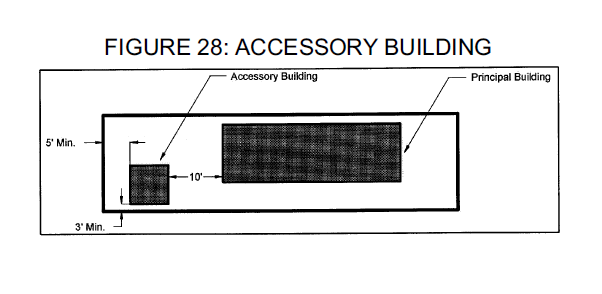
ACCESSORY STRUCTURE: A structure located on the same lot with the principal building, that is detached or attached, and is customarily incidental and subordinate to the use of the principal building.
ACCESSORY USE: A use that is customarily incidental and subordinate to the principal use of a lot or the main building thereon and located on the same lot as the principal use or building.
ADDITION OR ENLARGEMENT: Any construction that increases the size of a building or structure in terms of site coverage, height, length, width, or floor area.
ADVERTISING BENCH: Any bench that is used in whole or in part for advertising purposes by means of a message or design painted on, printed on, affixed to or otherwise designed as an integral part of the bench.
ALLEY: A public right of way that normally affords a secondary means of access to abutting property.
ALTERATION: Any change in the size, shape, character, occupancy, or use of a building or structure.
AMATEUR (HAM) RADIO EQUIPMENT: An amateur (ham) radio station licensed by the federal communications commission (FCC), including equipment such as, but not limited to, a tower or alternative tower structure supporting a single, radiating antenna platform and other equipment.
ARBOR: A freestanding structure used in the garden to support vines or climbing plants. See figure 29, "Arbor", of this definition for an example.

ARCHITECTURAL FEATURE: A part, portion, or projection that contributes to the aesthetics of a building or structure, exclusive of signs, that is not necessary for the structural integrity of the building or structure, or to make said building or structure habitable.
ARRAYS: A group of antennas arranged by a wireless telecommunications service provider and placed on a tower, structure, or building at a given height aboveground to provide the desired directional characteristics.
AWNING: A structure made of cloth, metal, or other materials affixed to a building in such a manner that the structure may be raised or retracted to a position against the building. For "awnings" with advertising, see definition of Sign, Awning. See figure 30, "Awning", of this definition.

BALCONY: A platform which projects from the exterior wall of a building above the ground floor, which is exposed to the open air, has direct access to the interior of the building, and is not supported by posts or columns extending to the ground.
BANNER: See definition of Sign, Banner.
BASEMENT: That portion of a building located partly underground, but having one-half (1/2) or more of its clear floor to ceiling height below the average grade of the adjoining ground. See figure 31, "Basement", of this definition.

BAY WINDOW: A window which projects outward from the building, beginning at least two feet (2') aboveground, which does not rest on the building foundation or on the ground. See figure 32, "Bay Window", of this definition.
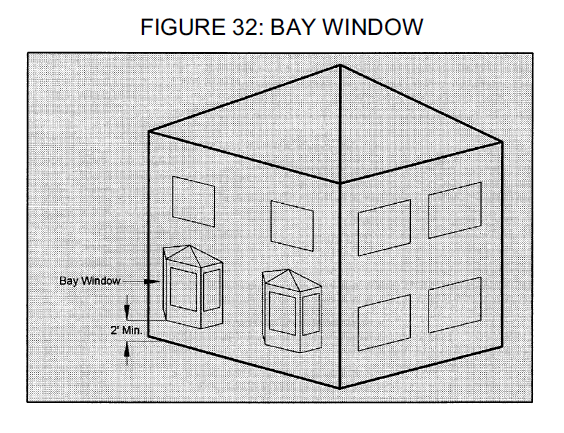
BERM: An earthen mound designed to provide visual interest on a site, screen undesirable views, reduce noise or fulfill other such purposes.
BLOCK: A tract of land bounded by streets or by a combination of one or more streets and public parks, cemeteries, railroad rights of way, bulkhead lines, shorelines of waterways or corporate boundary lines.
BOWLING ALLEY: Indoor facility for the sport of tenpin or duckpin bowling, with customary accessory uses such as snack bars.
BUFFER YARD: Land area with landscape plantings and other components used to visibly separate one use from another or to shield or block noise, lights, or other nuisances. See figure 33, "Buffer Yard", of this definition.
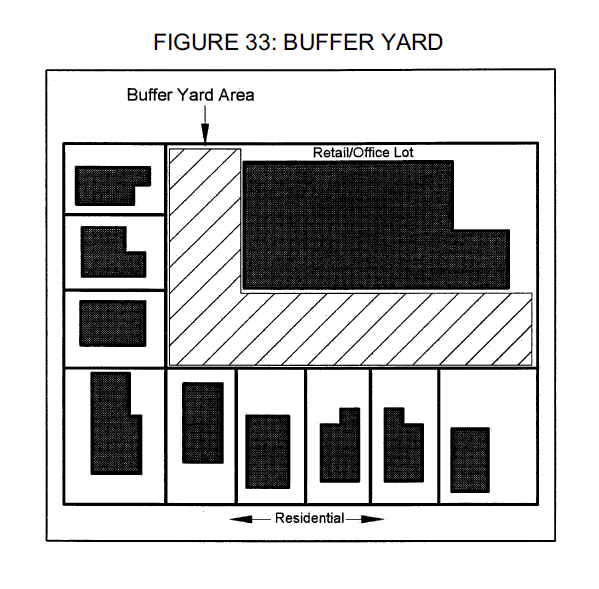
BUILDABLE AREA: The area of a lot remaining after the minimum yard and open space requirements of this title have been met.
BUILDABLE LOT: A lot on which a building or other structure may be erected in conformity with zoning and building code requirements.
BUILDING: A structure entirely separated from any other structure by space or by walls in which there are no communicating doors or windows, or similar openings, and having a roof supported by walls or columns for the shelter, support, or enclosure of persons or animals.
BUILDING, ACCESSORY: See definition of Accessory Building.
BUILDING, DETACHED: A building surrounded by open space on the same lot. A building connected to another building only by an unenclosed structure shall be deemed to be a separate detached building.
BUILDING HEIGHT, ACCESSORY BUILDING: The vertical distance measured from the established average finished grade to the highest point of the roof or the highest point of the structure.
BUILDING HEIGHT, PRINCIPAL BUILDING: The vertical distance measured from average finished grade, or proposed finished grade:
(A)In the case of a flat roof, to the highest point.
(B)In the case of a mansard roof, to the deck line.
(C)In the case of a gable, hip or gambrel roof, to the mean point between the eaves and the ridge.
Chimneys, spires, steeples, towers, elevator penthouses, tanks and similar projections other than signs shall not be included in calculating the height. See figure 34, "Building Height", of this definition.

BUILDING LINE: The inner edge of any required yard or setback, and the corresponding outer edge of the buildable area. Except as specifically provided by this title, no portion of any building or structure may be extended to occupy any portion of a lot outside its building lines.
BUILDING PERMIT: An official document issued by the building commissioner which authorizes the construction, alteration, enlargement, conversion, reconstruction, remodeling, rehabilitation, erection, demolition, moving, or repair of a building or structure.
BUILDING, RESIDENTIAL: A building which is arranged, designed, used or intended to be used for residential occupancy by one or more families or households and which includes, but is not limited to, the following types: single-unit dwellings, two-unit dwellings, three-unit dwellings, townhouse dwellings and multi- unit dwellings.
BUILDING, TEMPORARY: Any building not designed to be permanently located, placed or affixed in the place where it is or where it is intended to be placed.
BULK: The term used to indicate the size and setbacks of buildings or structures, and the location of the same with respect to one another, and includes, but is not limited to, the following:
(A)Size and height of buildings.
(B)Location of exterior walls at all levels in relation to lot lines, streets or other buildings.
(C)All open spaces allocated to buildings.
(D)Amount of lot area provided per dwelling unit.
BULLETIN BOARD: Any sign with a changeable message board erected in a permanent fashion by a public, charitable or religious institution that is erected upon the same property as said institution.
BUSINESS: An occupation, employment, or enterprise which occupies time, attention, labor and materials, or wherein merchandise is exhibited or sold, or where services are offered.
CALIPER: The American Association of Nurserymen standard for trunk measurement of nursery stock, as measured at six inches (6") above the ground for trees up to and including four inch (4") caliper size, and as measured at twelve inches (12") above the ground for larger sizes.
CANOPY: Any structure, other than an awning, made of materials such as cloth, metal, or other materials with a frame either attached to a building or projecting from a building and carried by a frame supported by the ground or sidewalk. For "canopies" with advertising see definition of Sign, Canopy. See figure 35, "Canopy", of this definition.
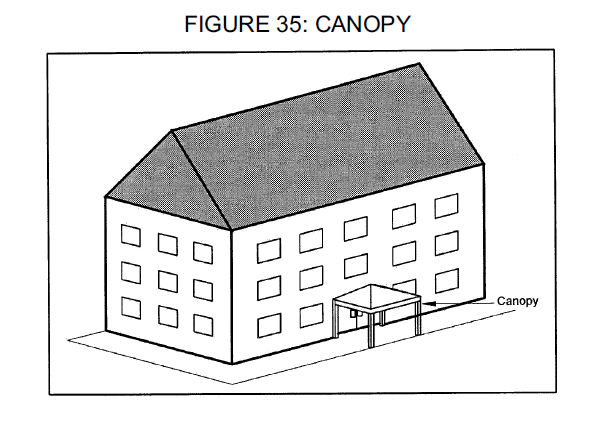
CARNIVAL/CIRCUS: A traveling or transportable group or aggregation of rides, shows, games, or concessions or any combination thereof.
CHIMNEY: A vertical shaft of reinforced concrete, masonry, or other approved material enclosing one or more flues, for the purpose of removing products of combustion from solid, liquid, or gaseous fuel.
CHRISTMAS TREE SALES LOT: A retail sales operation, generally conducted wholly outdoors, that offers for sale on a temporary, limited basis Christmas trees and related holiday items such as wreaths and Christmas tree stands.
COLLOCATION: Placement of wireless telecommunications equipment from more than one service or service provider on a single tower or site.
COMMERCIAL VEHICLE: Any vehicle operated for the transportation of persons or property in the furtherance of any commercial or industrial enterprise, for hire or not for hire, but not including a commuter van, a vehicle used in a ridesharing arrangement when being used for that purpose, or a recreational vehicle not being used commercially.
CONFORMING BUILDING OR STRUCTURE: Any building or structure that complies with all the regulations of this title, or any amendment hereto, governing bulk for the zoning district in which such building or structure is located or is designed or intended for a conforming use.
CONTIGUOUS: Adjoining or abutting.
DECK: A roofless outdoor space built as an aboveground platform projecting from the wall of a building and is connected by structural supports at grade or by the building structure.
DISTRICT: A portion of the village within which certain uniform regulations and requirements, or various combinations thereof, apply under the provisions of this title.
DRIP LINE: An imaginary line encircling a tree corresponding to the farthest extension of the tree branches. See figure 36, "Drip Line", of this definition.
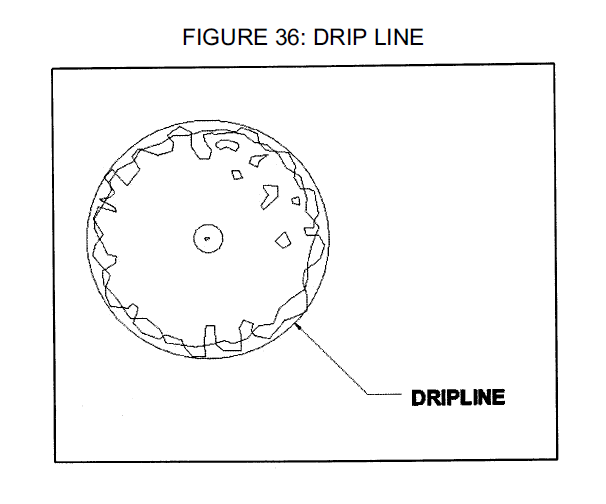
DRIVEWAY: A paved or unpaved access strip of land providing a vehicular connector between the public right of way of the street and a parking space or garage of private or public property.
DWELLING: A building or structure or portion thereof designed for occupancy by one family or household for residential purposes as a single housekeeping unit. In no case shall a motor home, trailer coach, tent, or portable building be considered a "dwelling".
DWELLING, ATTACHED: A dwelling designed as a single structure, containing separate dwelling units, each of which is designed to be occupied as a separate permanent residence for one household or family. Each dwelling is separated from the other by a wall extending from the ground to the roof or a ceiling and floor extending from exterior wall to exterior wall, except for a common stairwell exterior to both dwelling units.
DWELLING, DETACHED: A dwelling which is entirely surrounded by open space on the same lot.
DWELLING UNIT: A dwelling unit consists of a group of rooms constituting all or part of a dwelling, which are arranged, designed, used or intended for use exclusively as living quarters for one family or household, which include permanently installed bathroom and kitchen facilities.
EASEMENT: Land which has been designed by lawful agreement between the owner(s) of the land and a person(s) for a specified use only by such person(s).
EAVE: The projecting lower edges of a roof overhanging the wall of a building.
ENCROACHMENT: The extension or placement of any structure or building, or component of such, into a required yard.
ERECT: To build, construct, attach, hang, place, suspend, or affix.
FARMERS' MARKET: The seasonal selling or offering for sale of homegrown vegetables or produce, occurring in a predesignated area where the vendors are generally individuals who have raised the vegetables or produce or have taken the same on consignment for retail sale.
FARMSTAND: A temporary open air stand or place for the seasonal selling of agricultural produce. A farmstand is portable and capable of being dismantled or removed from the sales site.
FENCE: An artificially constructed barrier of wood, masonry, stone, wire, metal, or other combination of materials erected to enclose, screen, or separate areas.
FENCE, OPEN: A fence, including any gates, designed and constructed so that the surface area of any segment of such fence contains at least fifty percent (50%) open spaces as compared to solid materials.
FENCE, SOLID: A fence including any solid gates, which conceals from viewers in or on adjoining properties and streets, materials stored and operations conducted beyond it.
FLOOR AREA, GROSS: The sum of the horizontal areas of the several stories of a building, measured from the exterior faces of exterior walls, or in the case of a common wall separating two (2) buildings, from the centerline of such common wall. "Gross floor area" shall exclude basements, attics, driveways, parking spaces, and accessory uses and structures such as swimming pools, decks, and porches.
FLOOR AREA, NET: The sum of all floors of a building, used for human occupation, including basements, cellars and attics, used for such purposes and as measured from the exterior face of the walls. It does not include basements cellars, and attics, and unenclosed porches not used for human occupation or any floor space in accessory buildings or in the main building intended and designed for the parking of motor vehicles in order to meet the parking requirements of this title, or any floor space intended and designated for the operation or maintenance of the building, i.e., heating, air conditioning, ventilation, mechanical or electrical equipment, elevator machinery, elevator shafts, or stairwells.
FOOT-CANDLE: A unit of illumination. It is equivalent to the illumination at all points that are one foot (1') distant from uniform source of one candlepower.
FREQUENCY: Signifies the number of oscillations per second in a sound wave and is an index of the pitch of the resulting sound.
GARAGE: A building, either attached or detached, used or designed to be used for the parking and storage of vehicles by those resident upon the premises.
GAZEBO: A freestanding outdoor structure that is open sided in design for recreational use and not for habitation. See figure 37, "Gazebo", of this definition for an example.
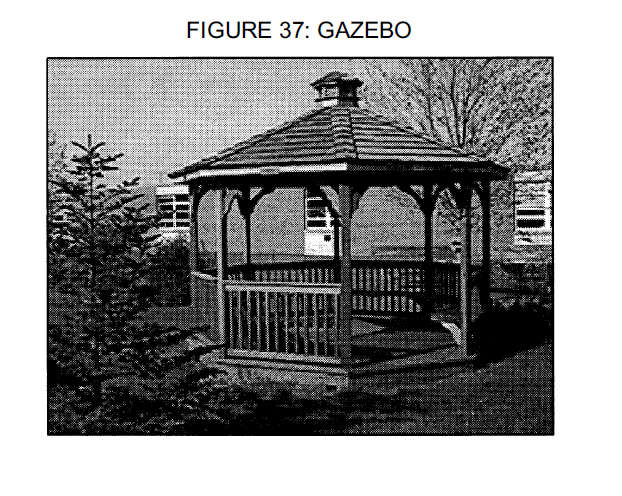
GRADE: The average level of the finished surface of the ground adjacent to the exterior walls of the building or structure.
GREENHOUSE, PRIVATE: A building or structure constructed chiefly of glass, glass like or translucent material, cloth or lath, which is devoted to the protection or cultivation of flowers or other tender plants.
HEDGE: A row of closely planted shrubs, bushes, or any kind of plant forming a boundary or fence.
HEIGHT: The vertical distance from grade to the highest point of a structure. See also definitions for building height.
HOUSEHOLD: Any number of individuals living together on the premises as a single housekeeping unit.
IMPERVIOUS SURFACE: A measure of intensity of land use that represents the portion of a site that is occupied by buildings, structures, pavement, and other impervious surfaces that do not allow for the absorption of water.
INCOMPATIBLE USE: A use that is incapable of direct association with certain other uses because it is contradictory, incongruous, or discordant.
INTENSITY OF USE: Square feet of gross floor area, number of dwelling units, number of employees, or other factor used as a basis for requiring parking or loading facilities.
LIGHTING, FULLY SHIELDED: A fixture that is shielded in such a manner that light rays emitted by the fixture, either directly from the lamp or indirectly from the fixture, are projected below a horizontal plane running through the lowest point on the fixture where light is emitted.
LIGHTING, UNSHIELDED: A fixture that allows light, either directly from the lamp or indirectly from the fixture or a reflector, to be emitted above the horizontal plane running through the lowest point on the fixture where light is emitted.
LOADING BERTH: A space within a loading facility exclusive of driveways, aisles, maneuvering areas, ramps, columns, landscaping areas, office, and work areas for the temporary parking of a commercial vehicle while loading or unloading goods or materials, and which abuts upon a street, alley, or other appropriate means of access.
LOGO: A business trademark or symbol.
LOT: A parcel or tract of land located within a single block, occupied, or intended for occupancy, by one principal building or principal use, and having frontage upon a street. See figure 38, "Lot Types", of this definition.

LOT AREA: The computed area contained within the lot lines.
LOT, CORNER: A lot situated at the junction of, and abutting on, two (2) or more intersecting streets. See figure 38, "Lot Types", of this section.
LOT COVERAGE: The portion of a lot that is occupied by buildings or structures, including accessory buildings or structures, expressed as a percentage of total lot area. See figure 39, "Lot Coverage", of this definition.
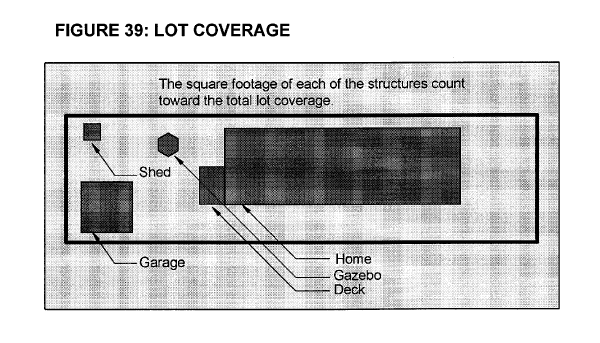
LOT DEPTH: The mean horizontal distance between the front lot line and the rear lot line of a lot, measured within the lot boundaries.
LOT, INTERIOR: A lot other than a corner lot or a through lot. See figure 38, "Lot Types", of this section.
LOT LINE: A property boundary line of any lot. Where any portion of the lot extends into an abutting street or alley, the lot line shall be deemed to be the established or existing street or alley right of way line.
LOT LINE, FRONT: The lot line which abuts an existing or dedicated street. For the purposes of this title, the "front lot line" of a corner lot shall be the shortest street frontage of the lot.
LOT LINE, REAR: That boundary of a lot which is most distant from and is, or is approximately, parallel to the front lot line.
LOT LINE, SIDE: Any boundary of a lot that is not a front lot line or a rear lot line.
LOT OF RECORD: A lot which is part of a recorded subdivision, or a lot or parcel described by metes and bounds, the description of which has been so recorded.
LOT, THROUGH: A lot having frontage on two (2) streets at opposite ends of the lot, which is not a "corner lot". See figure 38, "Lot Types", of this section.
LOT WIDTH: The distance between the side lot lines of a lot measured by a straight line drawn between the intersections of the side lot lines with the front building line.
LOT, ZONING: A single tract of land located within a single block which, at the time of filing for a building permit, is designated by its owner or developer as a tract to be used, developed or built upon as a unit, under single ownership or control. A "zoning lot" may or may not coincide with a "lot of record".
LUMINAIRE: A complete lighting unit extending from a support structure, parallel to the ground, consisting of a light source and all necessary mechanical, electrical and decorative parts. A "luminaire" does not include a pole or other support.
MARQUEE: A permanent roof like structure constructed of durable material extending from part of the wall of a building but not supported by the ground.
MEMORIAL PLAQUE: A sign, tablet, or plaque memorializing a person, event, structure, or site.
MOTOR VEHICLE: Any self-propelled wheeled vehicle designed primarily for transportation of persons or goods along public streets.
MOVIE THEATER: A theater designed for showing movies or motion pictures.
NAMEPLATE: A sign indicating the name, address or profession of the person or persons occupying the lot or a part of the building.
NONCONFORMING LOT: A lot of record that does not meet the lot area or lot width requirements of this title for the zoning district in which it is located.
NONCONFORMING USE, BUILDING OR STRUCTURE: An existing use, building or structure, or part or appurtenance thereof, not in conformance with the requirements of this title.
OFF PREMISES SIGN: A sign, typically a freestanding wall or roof sign, that advertises a business or product but is not located on the premises where the business is located or the product is the primary product available for sale. An "off premises sign" is also known as a billboard.
OFF STREET PARKING: The storage space for an automobile on premises other than streets or right of way.
ON RIGHT OF WAY PARKING: The storage space for an automobile that is located within the street right of way. See figure 40, "On Right Of Way Parking", of this definition.
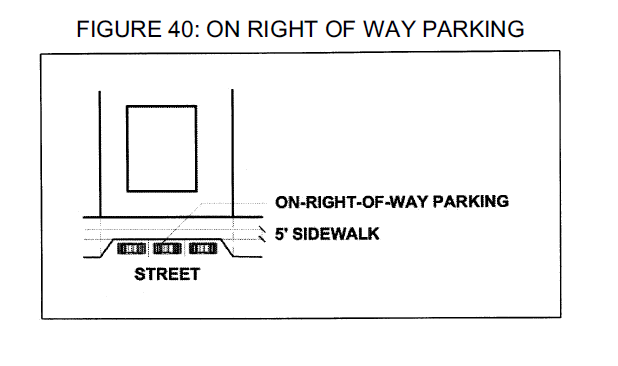
OPTION TO BUY: A right given by the owner of property to another to buy certain property within a limited time at an agreed price.
OUTDOOR DISPLAY AND SALES AREA: Part of a lot used for outdoor sales and/or display of goods accessory to the principal use.
OUTDOOR STORAGE: The keeping of any goods, material, merchandise or equipment not within an enclosed building, including incidental maintenance and repair of the material which is being stored.
OWNER: A titleholder of record, or if title is held in trust, the beneficiary of the trust.
PARKWAY: The area, excluding the sidewalk, if any, between the property line and the curb or, in the absence of a curb, between the property line and the nearest edge of the street paving.
PARTY WALL: A wall starting from the foundation and extending continuously through all stories to or above the roof, that separates one building from another, but is in joint use by each building.
PATIO: An impervious surface, no higher than one foot (1') above the ground, designed and intended for recreational use by people and not as a parking space.
PEDESTRIAN WALL: An upright structure of building material, such as masonry or plaster, serving to enclose, divide, or protect an area.
PERFORMANCE STANDARDS: A criterion to control noise, odor, smoke, toxic or noxious matter, vibration, fire, and explosive hazards, or glare of heat generated by or inherent in use of land or buildings.
PERGOLA: A freestanding structure usually consisting of parallel colonnades supporting an open roof of girders and cross rafters. A "pergola" is built as an outdoor sitting area with lattice or open slat roof for partial shade. See figure 41, "Pergola", of this definition for an example.

PERSON: An individual, proprietorship, partnership, corporation, association, or other legal entity.
PERSON WITH A DISABILITY: Any individual whose disability:
(A)Is attributable to mental, intellectual or physical impairments or a combination of mental, intellectual, or physical impairments.
(B)Is likely to continue for a significant amount of time or indefinitely.
(C)Results in functional limitations in three (3) or more of the following areas or major life activities:
1. Self-care.
2. Receptive or expressive language.
3. Learning.
4. Mobility.
5. Self-direction.
6. Capacity for independent living.
7. Economic self-sufficiency.
(D)Reflects the person's need for a combination and sequence or special interdisciplinary or generic care, treatment, or other services which are of a lifelong or extended duration.
POOL HALL: Establishments that provide, as a principal use, pool tables or billiard tables or a combination thereof for customer use.
PORCH: A structure, which can be enclosed or unenclosed, that projects from the exterior wall of a building, has direct access to the street level of the building, and is covered by a roof or eaves.
PRINCIPAL BUILDING: A nonaccessory building in which a principal use of the lot on which it is located is conducted.
PRINCIPAL USE: The main use of land or buildings as distinguished from an accessory use.
PROPERTY LINE: The lines bounding a zoning lot.
PUBLIC USE AREA (For Parking Standard Calculations): The area within a use where the public or a substantial number of the public has access to, including, but not limited to, such areas as dining rooms, restrooms, bar seating, display areas, etc.
PUMPKIN PATCH: A retail sales operation, generally conducted wholly outdoors, that offers for sale on a temporary, limited basis pumpkins and related holiday (Halloween) items.
REAL ESTATE MODEL UNIT: A residential unit temporarily used for display purposes as an example of dwelling units available or to be available for sale or rental in a particular subdivision or other residential development. Model units may also incorporate sales or rental offices for dwellings within the development.
RECREATIONAL VEHICLE: A vehicular unit, which is designed as a temporary dwelling for travel, recreational and vacation use, and which is self-propelled, mounted on or pulled by another vehicle. Examples include, but are not limited to, a travel trailer, camping trailer, truck camper, motor home, fifth wheel trailer, or van.
REFUSE: All waste products resulting from human habitation or the conduct of business or industry, except sewage.
RESIDENTIAL DEVELOPMENT SIGN: An identification sign used to indicate the entrance to a subdivision or unified residential area.
RETAINING WALL: A raised area of soil with the top leveled, supported around the edges by stone or timber, designed to resist lateral earth and/or fluid pressures, including any surcharge. This definition of "retaining wall" shall, for the purposes of this title, include terracing used in landscaping. See figure 42, "Retaining Wall", of this definition for an example.
FIGURE 42: RETAINING WALL

SATELLITE DISH ANTENNA: A dish antenna designed for transmitting signals to a receiver or receiving station or for receiving television, radio, data, communication or other signals from other antennas, satellites, or other services.
SECONDARY LIVING UNIT: A detached secondary residential dwelling unit located on the same lot as a single-family dwelling unit, either located within a detached accessory structure, typically referred to as a "coach house". Also that living space within a detached garage, typically in the space above the ground floor parking stalls.
SETBACK: The required minimum distance from a lot line to a building or structure, or other improvement on a lot. See figure 43, "Setback", of this definition.
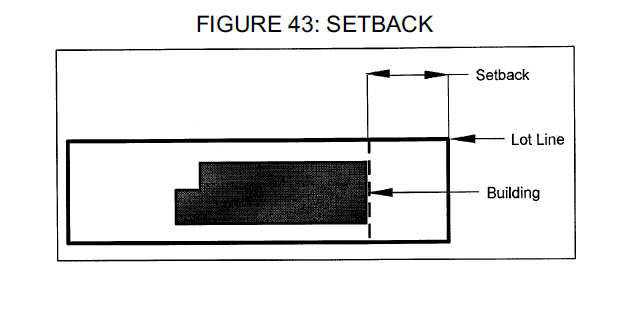
SHADE TREE: A deciduous tree planted primarily for its high crown of foliage or overhead canopy. A large shade tree is over forty feet (40') in height. Medium shade trees are between twenty five (25) and forty feet (40') in height. Small shade trees reach up to twenty five feet (25') in height.
SHED: A relatively small accessory building often purchased prebuilt or as a kit in prefabricated sections. It is not designed to be served by heat, electricity, or plumbing and does not need to be placed on a permanent foundation. A "shed" is typically intended to store lawn, garden, or pool care equipment.
SHOPPING CENTER: A group of retail and other commercial establishments that is planned, owned and managed as a single property. The center's size and orientation are generally determined by the market characteristics of the trade area served by the center. The two (2) main configurations of shopping centers are malls and strip centers.
SIGN: A name, identification, description, display, illustration or attention getting device which is affixed to or painted or represented directly or indirectly upon a building or other outdoor surface or lot, and which directs attention to a person, business, product, service, place, organization or entertainment. "Sign" shall not include the flag of any nation, state or governmental entity.
SIGN, A-FRAME: An advertising device ordinarily in the shape of an "A", or some variation thereof, located on the ground, not permanently attached and easily movable, and usually two (2) sided. See figure 44, "A-Frame Sign", of this definition.
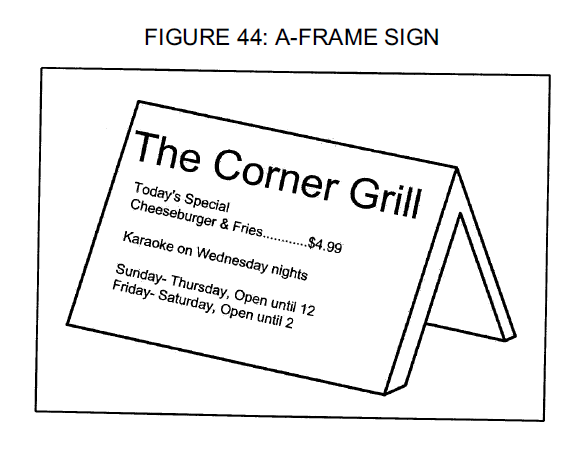
SIGN, AWNING: A sign that is mounted or painted on, or attached to, an awning.
SIGN, BANNER: Any sign printed or displayed upon cloth or other flexible material with or without frames.
SIGN, BENCH: See definition of Advertising Bench.
SIGN, CANOPY: A sign that is painted on, printed on, or attached to a canopy.
SIGN, DIRECTIONAL: A sign that identifies parking lot entrances and exits, restrooms, public telephones, walkways, parking lot entrances and exits, and features of a similar nature.
SIGN, DIRECTORY: A sign that serves as common or collective classification for a group of persons or businesses operating on the same zoning lot (e.g., shopping center, office complex, etc.). Such sign may name the persons or businesses included, but carry no other advertising matter.
SIGN, ELECTRONIC: Signs whose alphabetic, pictographic, or symbolic informational content can be changed or altered on a fixed display screen composed of electrically illuminated segments. For the purposes of this title, "electronic signs" shall be regulated as one of the two (2) following types:
(A)Electronic Display Screen: A sign, or portion of a sign, that displays an electronic image or video, which may or may not include text. This definition includes television screens, plasma screens, digital screens, flat screens, LED screens, video boards, and holographic displays.
(B)Electronic Message Center: Any sign or portion of a sign that uses changing lights to form a sign message or messages in text form wherein the sequence of messages and the rate of change is electronically programmed and can be modified by electronic processes.
SIGN, FREESTANDING: A sign that is attached to a completely self- supporting structure. The supporting structure shall be set firmly in and/or below the ground surface and shall not be attached to any building or structure, whether portable or stationary. A freestanding sign may be a pole or monument sign. See also definition of Sign, Freestanding - Monument and Sign, Freestanding - Pole.
SIGN, FREESTANDING - MONUMENT: Any sign, other than a pole sign, placed upon or supported by the ground independently of any other structure. "Freestanding monument signs" are typically mounted on a masonry base. See also definition of Sign, Freestanding.
SIGN, FREESTANDING - POLE: A sign erected and maintained on one or two (2) freestanding mast(s) or pole(s) and not attached to any building, but not including "freestanding monument signs". See also definition of Sign, Freestanding.
SIGN, MUNICIPAL: A sign erected and maintained pursuant to, and in discharge of, any municipal functions or as required by law, including, but not limited to, speed limit signs, stop signs, village limit signs, street name signs, historical or government sites, and directional signs.
SIGN, NONCONFORMING: A sign lawfully erected and maintained prior to the adoption hereof that does not conform to the requirements of this title.
SIGN, OCCUPATIONAL: A sign indicating the name and profession of an occupant of the lot or a part of the building.
SIGN, OFF PREMISES: A sign which directs attention to a business, commodity, service or entertainment conducted, sold, or offered at any location other than upon the premises where such sign is located or to which it is affixed.
SIGN, POLITICAL: A sign advocating action on a public issue or recommending a candidate for public office.
SIGN, PORTABLE: A sign whose principal supporting structure is intended, by design and construction, to be used by resting upon the ground for support and may be easily moved or relocated for reuse. Portable signs shall include, but are not limited to, signs mounted upon a trailer, wheeled carrier or other nonmotorized mobile structure, with wheels or with wheels removed.
SIGN, PROJECTING: Any sign that is attached to a building or other structure, and extends beyond the surface of the building or structure to which it is attached.
SIGN, ROOF: Any sign wholly erected, constructed, or maintained upon or above the roof structure or parapet of any building with the principal support attached to the roof structure. See figure 45, "Roof Sign", of this definition.
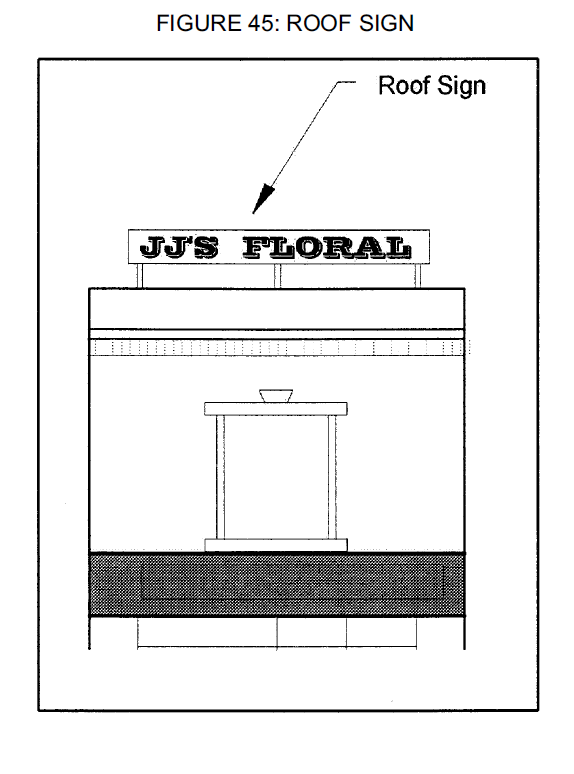
SIGN SUPPORT STRUCTURE: Any structure that supports, or is capable of supporting, a sign, including decorative cover.
SIGN, WALL: A sign mounted flat against and projecting less than twelve inches (12") from the wall of a building or structure with the exposed face of the sign in a plane parallel to the face of the wall. "Wall sign" shall not include "window sign" as defined herein.
SIGN, WINDOW: A sign attached to, placed upon, or printed on the interior or exterior of a window or door of a building intended for viewing from the exterior of such a building. A "window sign" may be either permanent or temporary.
STOOP: An exterior floor typically, but not necessarily, constructed of concrete and/or masonry, with a finished floor elevation higher than the adjacent ground level, often with steps leading up to it, and utilized primarily as an access platform to a building.
STORY: That portion of a building included between the surface of a floor and the surface of the floor next above, or if there is no floor above, the space between the floor and the ceiling or roof above it. See figure 46, "Story", of this definition.
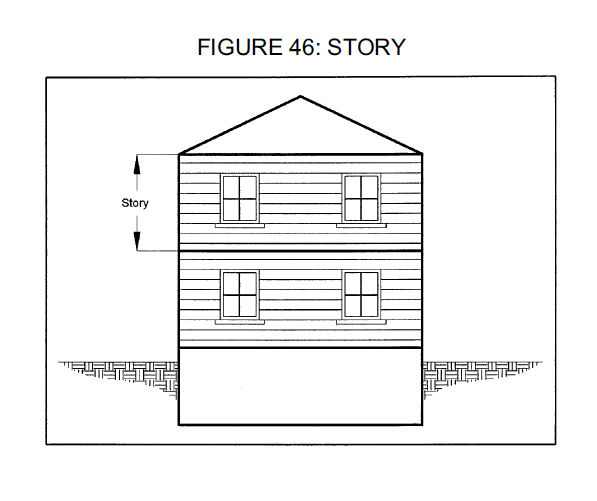
STREET: An improved right of way that affords a primary means of access to abutting property.
STREET LEVEL: The story of a building that has its floor at the closest level to the street, with direct pedestrian access to that story from the outside.
STREET WALL: The wall of a building nearest to and facing on a street.
STRUCTURAL ALTERATION: Any change in the supporting members of a building or structure, such as bearing walls or partitions, columns, beams or girders, or any substantial change in the roof or exterior walls.
STRUCTURE: Anything erected, the use of which requires more or less permanent location on the ground or attached to something having a permanent location on the ground.
SWIMMING POOL: A receptacle for water and/or an artificial pool of water over twenty four inches (24") in depth, or with a surface area exceeding two hundred fifty (250) square feet either at a private residence intended only for the use of the individual owner, his family and friends, or at a multiple-unit residence intended only for the use of the tenants of the building, their families and friends. "Swimming pool" does not include portable or temporary type of pools of plastic, rubberized cloth or similar material installed above ground level.
TEMPORARY CONTRACTOR TRAILER: This use includes watchmen's trailers, construction equipment sheds, contractor trailers and similar uses incidental to a construction project and sales of homes within a newly constructed development.
TEMPORARY STORAGE CONTAINER: Temporary self-storage containers delivered to residential or commercial uses for the resident or business owner to store belongings, and then picked up and returned to a warehouse until called for. Also known as "PODS" (portable on demand storage containers).
TEMPORARY STORAGE TRAILER: This use includes watchmen's trailers, construction equipment sheds, contractor trailers and similar uses incidental to a construction project and sales of homes within a newly constructed development.
USE: The purpose or activity for which the land or building thereon is designed, arranged or intended, or for which it is occupied or maintained.
USE, PERMITTED: A use permitted in a zoning district without the need for special administrative review and approval, upon satisfaction of the standards and requirements of this title.
USE, SPECIAL: A use that owing to some special characteristics attendant to its operation or installation is permitted in a zoning district only after review, and is subject to approval by the village board.
VARIATION: A decision of the board of zoning appeals that, if approved by the village board, permits an applicant to depart from the precise regulations of this title. A variation may be granted only in the specific instances authorized in this title and only in accordance with the standards of this title.
YARD: A required open space on a lot which is unoccupied and unobstructed from its lowest level to the sky, except for obstructions specifically permitted by this title. A yard extends along a lot line for a depth specified by the zoning district in which such lot is located. See figure 47, "Yards", of this definition.
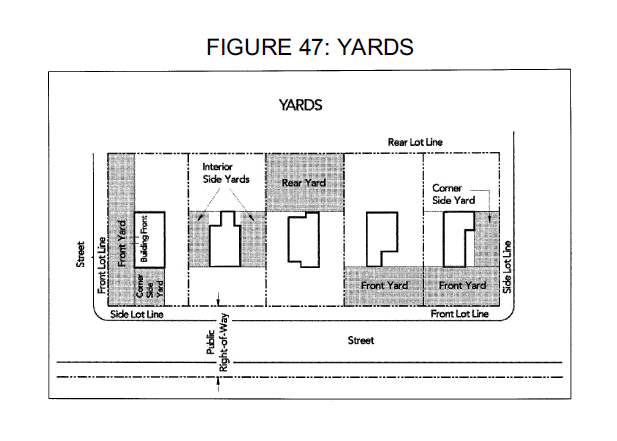
YARD, CORNER SIDE: A side yard on a corner lot which faces a public street. See figure 47 of this section.
YARD, FRONT: A yard extending the full width of the lot between side lot lines for the required minimum depth, as specified by the zoning district in which such lot is located, measured perpendicular to the front lot line. See figure 47 of this section.
YARD, INTERIOR SIDE: A side yard which does not abut a street right of way. See figure 47 of this section.
YARD, REAR: A yard extending between the side lot lines for the required minimum depth, as specified by the zoning district in which such lot is located, measured perpendicular to the rear lot line. See figure 47 of this section.
YARD, SIDE: A yard extending along a side lot line between the front and rear yard, for the required minimum depth, as specified for the district in which such lot is located, measured perpendicular to the side lot line. See figure 47 of this section.
ZONING AMENDMENT, MAP: A change in the zone boundaries or area district boundaries upon the zoning map.
ZONING AMENDMENT, TEXT: A change in the wording, context, or substance of the zoning ordinance.
ZONING CERTIFICATE: A zoning certificate which authorizes buildings, structures, or uses consistent with the terms of this zoning ordinance for the purpose of carrying out and enforcing its provisions. (Ord. 2006-37, 12-21-2006)